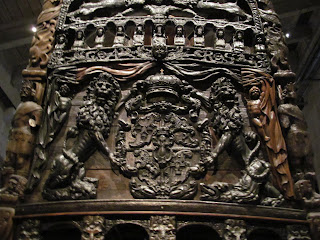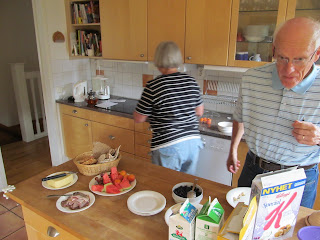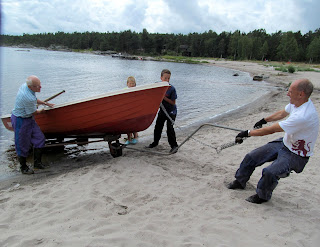SATURDAY, AUGUST 11, 2012—Vasa Museum
We stayed around home this morning to regroup. Then, in the early afternoon, Mari-Anne and I took the train into Stockholm and went to the Vasa Museum—one of the “must see” museums in Stockholm. And I wasn’t disappointed!
Sweden was embroiled in an ongoing war with Poland in 1628. In 1625, the Swedish King, Gustavus II Adolphus, ordered a “Royal Ship” built, the 17th century designation for the largest type of naval vessel. Construction began in 1626 and 1,000 oak trees were felled for the ship. The ship named “Vasa” was to be the most powerful warship in the world. Vasa’s maiden voyage from Stockholm harbor took place on August 10, 1628, and it sailed approximately 4,300 feet before capsizing after it was hit by a slight gust of wind. The ship had masts more than 50 meters (165 feet) high, 10 sails, 64 large guns, and hundreds of gilded and painted sculptures. Decorative artwork on the Vasa included 500 figure sculptures and over 200 carved ornaments. The hull length was 156 feet while the maximum width was 38 ½ feet. The draft was 15.8 feet—not much for a ship of this size, in my estimation. It was outfitted to carry ballast and ammunition in addition to 145 crewmembers, 300 soldiers (not on board) and supplies. Family members of the crew were on board for the inaugural sailing. Approximately 50 people went down with the ship.
 |
| 1:10 Scale Model of VASA |
 |
| Exhibit Showing Life Aboard VASA |
 |
| The VASA |
All too soon, it was time for the museum to close and we made our way back to Jakobsberg, arriving about 2000. Gunnar said the next-door neighbors would be over about 2030 for coffee, so we ate a quick dinner. The neighbors arrived as planned and I was delighted to see Sven Erik again and meet his wife, Britt. They had lent us the use of their condo in Åre and we spent the rest of the evening reminiscing about our trip there. We also had an interesting discussion of some of the social differences between Sweden and the U.S. Overall, it was another day full of “discoveries” and interesting conversations.
FAST FACTS: In Sweden, 16 months of parental leave is granted after a child is born, which continues through age seven. Both parents are expected to share the leave; however, fathers must take a minimum of 60 days or forfeiture requirements kick in. The government reimburses the parents for a portion of salaries lost during this time (80% for most people) and the parents do not have to be married to qualify for the leave. The rules are quite complicated, but this explains the policy briefly. Incidentally, I found out while researching this fact, that the U.S. is one of four nations without a national parental leave law. The others are Liberia, Papua New Guinea and Swaziland.
SUNDAY, AUGUST 12, 2012—Grisslehamn
We were up early, ate another of the Mari-Anne and Gunnar’s traditional bountiful breakfasts (some of which I have adopted, I liked it so much), and got in the car for the 90-minute drive to Grisslehamn, a small community northeast of Stockholm right on the Baltic Sea coast.
 |
| Breakfast at the Stignäs Home |
It was a very pleasant drive to the Stignäs’ summer home, which I found, was near summer homes owned by their children. The families spend quite a lot of time there during the summer and the grandchildren have wonderful opportunities to enjoy each other as well as having quality time with their grandparents. I really enjoyed meeting Mari-Anne and Gunnar’s children and grandchildren (all but two older grandsons). This was important to me because now I can put faces with names when I read about them in Mari-Anne’s emails or on various Facebook posts. It was also very nice to see their summer homes for the same reasons. The location along the coast is idyllic and I can certainly see why they like to spend as much time as possible there!
After closing up the home, we went into town where we had some very good fish soup at water’s edge. This was topped off with an ice cream cone after bagging a geocache (what else?), followed by a short hike. Too soon, it seemed, it was time to head back to Jakobsberg. Mari-Anne prepared the fresh cod she had bought in Grisslehamn for dinner that night which was delicious. I have eaten a lot of cod through the years and have always liked it; however, this was out of this world! This drew to close a very nice day with the Stignäs family.
FAST FACTS: As with other European countries, people in Sweden have generous vacation leave (by U.S. standards), which they tend to use.












